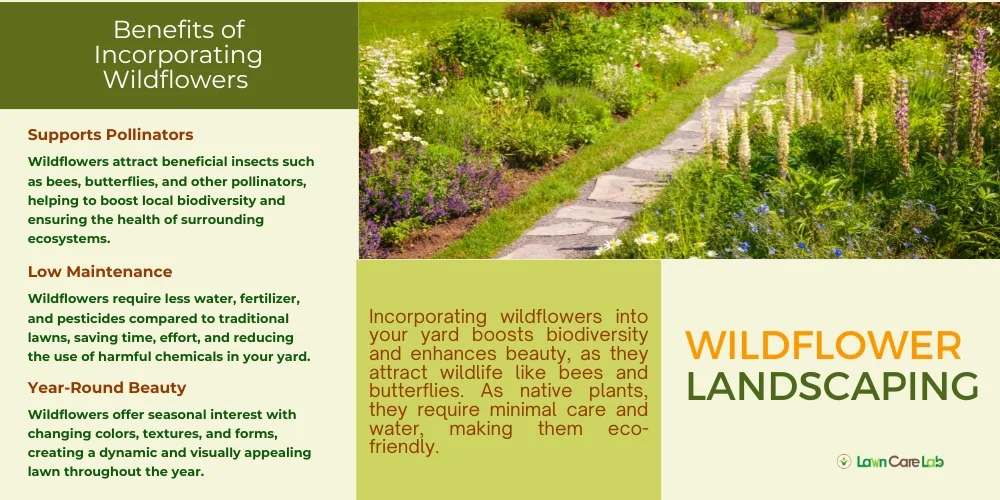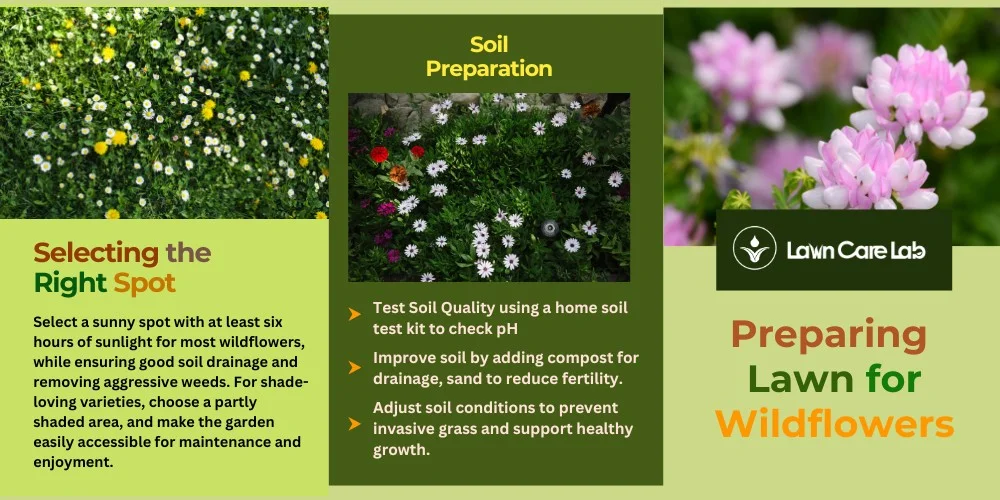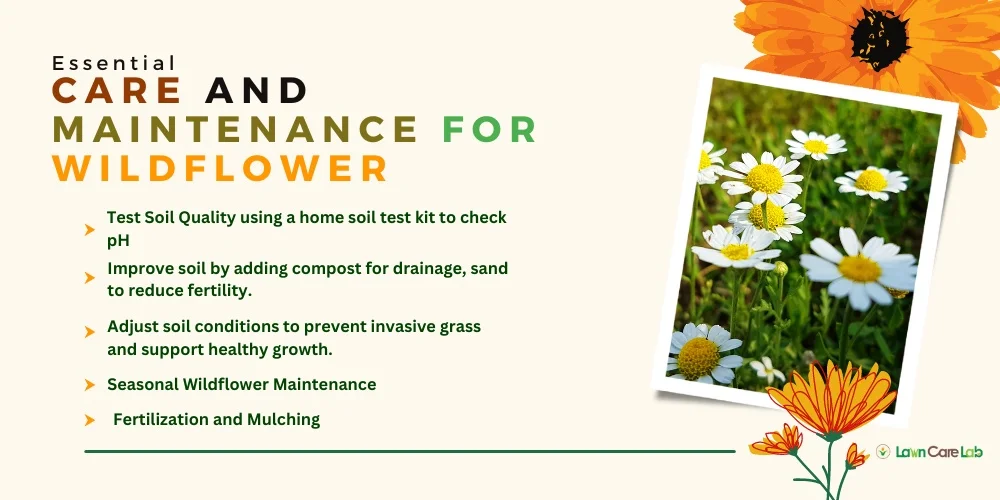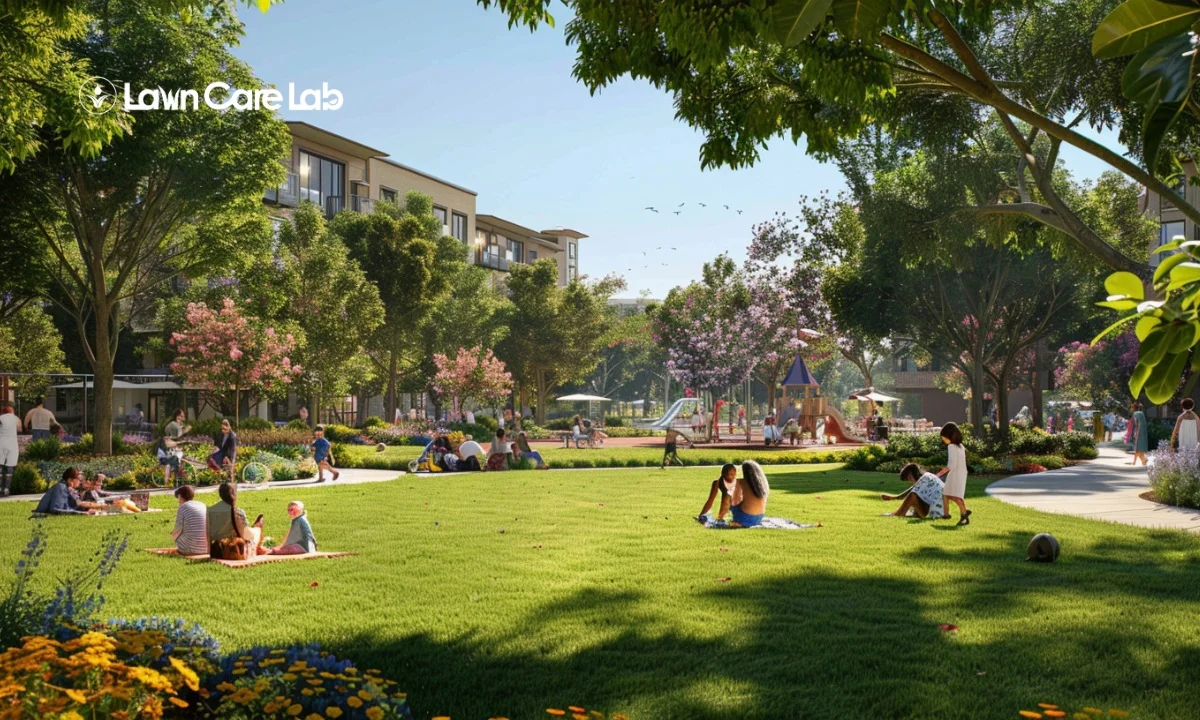Transforming your lawn into a wildflower haven is an excellent way to enhance the beauty of your outdoor space while supporting biodiversity and minimizing maintenance efforts.
By replacing traditional grass lawns with native wildflowers, you’ll create an ecosystem that thrives naturally in your local conditions. Native plants are well-adapted to the climate and soil of your region, which reduces the need for frequent watering, fertilizers, or chemical pesticides. This not only saves you time and effort but also promotes a healthier environment.
This guide will show you how to plant and maintain wildflower, a sustainable, beautiful outdoor space that benefits both you and the environment , contributing to a healthier planet while providing a vibrant, natural landscape for your enjoyment..
Table of Contents
Introduction to Wildflower Landscaping
Incorporating wildflowers into your yard offers environmental and aesthetic benefits. Being native plants, wildflowers thrive in local conditions with minimal water and no chemical fertilizers, making them eco-friendly additions to your garden.

Wildflowers also attract local wildlife such as birds, bees, and butterflies, supporting biodiversity. For example, planting milkweed encourages monarch butterflies to feed and breed in your yard.
Using region-specific seed mixes, like the ‘All-Native Wildflower Mix’ from American Meadows, enhances both the beauty of your garden and the local ecosystem.
Benefits of Incorporating Wildflowers in Your Lawn
Wildflowers bring more than beauty—they support pollinators like bees and butterflies, boosting biodiversity and improving your garden’s health. These plants require less water and fewer chemicals than traditional lawns, reducing maintenance and making your yard safer.
Their deep roots improve soil structure, promote water retention, and help prevent erosion, offering long-term benefits for your landscape. Wildflowers provide year-round interest with changing colors and textures each season.
Preparing Your Lawn for Wildflowers
Before planting wildflowers, choose a sunny, well-drained area and check the soil’s pH and nutrients. Add compost to improve soil quality, like Organic Mechanics Planting Mix, to create a healthy environment for wildflowers to thrive.
It’s important to check the soil’s pH and nutrients because wildflowers need specific conditions to thrive. You can improve the soil by adding organic matter like compost. This helps the wildflowers grow strong and healthy.

Here’s why good soil matters: Wildflowers do best in environments that suit their natural needs. By adjusting your soil, you mimic their native habitats, which boosts their growth.
When adding compost, a product like Organic Mechanics Planting Mix can be beneficial. It’s eco-friendly and works well for enhancing soil health.
Selecting the Right Spot
Choosing the right location is crucial for your wildflower garden to thrive. Look for a spot that gets full sun for at least six hours daily, as most wildflowers need this to grow well.
If you plan to include shade-loving wildflowers, opt for an area that gets some shade during the day. Ensure the soil drains well to prevent root rot and other moisture-related diseases.
Before planting, remove any aggressive grasses and weeds to help your wildflowers thrive without competing for resources.
Also, choose a location that’s easy to see and reach, so you can enjoy and take care of your garden with ease.
Soil Preparation for Wildflowers
Before you begin planting wildflowers, it’s crucial to check your soil’s quality. This step helps you understand the soil’s current state and what changes you may need to make.
You should aim to modify the soil’s texture and nutrient levels. This is important because slightly less fertile soil helps prevent invasive grass from growing and supports the growth of native wildflowers.
To start, you can use a simple soil test kit available from your local garden center. This will tell you about the nutrient content and pH level of your soil.
Based on the results, you might need to add certain amendments. For instance, if your soil is too dense, adding compost can improve its texture and drainage. This creates a better environment for wildflowers, which typically thrive in less fertile soil.
Testing Soil Quality
Starting a wildflower garden begins with testing your soil’s quality. Here’s a straightforward guide to do it effectively:
- Check pH Levels: Your soil’s pH should be between 6.0 and 7.0. This range is crucial because it affects how well plants can absorb nutrients.
- Evaluate Nutrients: Use a home testing kit to quickly find out what your soil has and what it’s missing. This step helps you understand if you need to add anything to support plant growth.
- Analyze Soil Texture: Feel your soil to see if it’s more like clay, sand, or loam. Each type affects water drainage and root growth differently.
- Send for Professional Testing: For a thorough analysis, get your soil tested by a local extension service. They can provide detailed insights that are especially helpful if you’re seeing plant growth issues.
Enhancing Soil for Wildflower Growth
After checking the quality of your soil, you might need to improve it to ensure wildflowers thrive.
| Condition | Issue | Solution |
|---|---|---|
| Nutrient-rich | Too lush growth | Mix in sand to lower fertility |
| Compacted soil | Waterlogging | Add compost or peat to enhance drainage |
| Low organic | Fragile soil | Incorporate organic materials |
| Poor aeration | Hindered growth | Aerate and mix in peat |
| High acidity | Blocked nutrients | Use lime to balance pH |
By focusing on soil preparation and location, you can create a nurturing environment that supports the natural growth of wildflowers and allows them to flourish in your lawn.
Choosing the Right Wildflower Seeds
When choosing wildflower seeds, it’s important to pick native species. These are better for the environment and require less upkeep because they naturally fit with local ecosystems.
Native plants help increase biodiversity and make your garden healthier and more attractive. For example, if your area has a lot of bees, consider planting purple coneflower or black-eyed Susan, which are both known to support bee populations.
Native vs. Non-native Species
Selecting the right wildflower seeds involves an important choice between native and non-native species. Here is why choosing native species is usually the better option:
- Adaptability: Native wildflowers naturally thrive in your local climate and soil. This means they’re more likely to grow well with less help from you.
- Support for Wildlife: Native plants are crucial for local animals. They provide the necessary shelter and food these animals need to survive.
- Less Resources Needed: Native wildflowers generally don’t need as much watering or fertilizing. This helps you reduce your impact on the environment.
- Lower Invasive Risk: Choosing native plants helps maintain the balance of your local ecosystem. Non-native plants can sometimes spread quickly and take over, harming native species.
Blending Wildflowers with Your Current Lawn
It’s important to choose the right native plant seeds to integrate wildflowers into your lawn. Here’s a simple guide to help you get started.
| Wildflower | Soil Type | Compatibility |
|---|---|---|
| Black-eyed Susan | Well-drained | High |
| Purple Coneflower | Clay, Loamy | Medium |
| California Poppy | Sandy, Loamy | High |
| Blue Flax | Rocky, Sandy | Medium |
| Lupine | Acidic, Sandy | High |
Thin out your lawn grass to give wildflowers room to grow. Adjust mowing frequency to support both grass and flowers. This balance enhances garden beauty and supports local biodiversity.
Planting Your Wildflower Seeds
After picking your wildflower seeds, it’s crucial to plant them at the right time. Aim for the beginning of the rainy season in your area, as this gives the seeds plenty of water to grow.
Plant the seeds shallowly so they touch the soil well, which is important for them to sprout properly. Planting during the rainy season means your wildflowers will have enough moisture to start growing without extra watering, saving water and helping the seeds develop better.
Optimal Timing for Planting
The success of your wildflower garden largely depends on planting at the right time. Choose the beginning of your local rainy season to ensure seeds receive adequate water naturally, promoting healthy growth with minimal extra effort.
- Spring Planting: This is an ideal time to plant in areas with regular spring rain. The combination of warmth and moisture encourages quick germination and vigorous growth.
- Fall Planting: In regions with mild winters and good fall rains, planting in autumn allows seeds to undergo stratification over winter, enhancing spring germination.
Adjusting your planting schedule to local climate patterns and aligning with the natural lifecycle of wildflowers will give the best results.
Techniques for Sowing Wildflower Seeds
When you’re planning to plant wildflower seeds, you can choose from two methods: broadcast seeding or row seeding.
Broadcast seeding means spreading the seeds all over the soil. This method covers big spaces and creates a natural-looking flower area. It’s great if you want a wild, informal garden.
On the other hand, row seeding involves placing seeds in specific lines. This method is good for smaller gardens or when you want everything neat and organized. It makes caring for the garden easier because you know exactly where each plant should grow.
Broadcast Seeding Method
This method involves scattering seeds over a large area, creating a more natural, free-flowing appearance. It works best for larger spaces and wildflower meadows.
Steps for Broadcast Seeding:
- Mix seeds with sand for even distribution.
- Scatter the mixture across the soil evenly.
- Lightly rake to ensure seeds make contact with the soil.
- Press seeds into the soil by walking over the area or using a roller to prevent them from being blown away or eaten.
Example: Ideal for large spaces like meadows or informal garden designs where sunflowers, daisies, or other wildflowers can thrive.
Row Seeding Method
Row seeding provides a tidy, manageable layout for smaller or more organized gardens. This method is useful when you need control over spacing and garden organization.
Steps for Row Seeding:
- Use stakes and strings to mark straight lines.
- Plant seeds along the rows for a neat, structured appearance.
- Row seeding makes weeding and watering easier and ensures even spacing for optimal plant growth.
Example: Use for garden borders or small flower beds where organization and aesthetics are key.
Essential Care and Maintenance
After you’ve sown your wildflower seeds, it’s crucial to ensure they get enough water, particularly during the early growth stages. This helps them sprout and take root effectively.

Keep an eye out for weeds too, as they can stifle your wildflowers by hogging nutrients and light.
Here is the essential care and maintenance guidelines for Wildflower areas:
1. Watering Your Wildflower Area:
Proper watering is crucial during the initial phase when seeds are just sprouting and roots are forming.
- Initial Watering: Ensure the soil is adequately soaked during planting for successful germination.
- Regular Monitoring: Keep the soil moist, avoiding waterlogging.
- Weather Consideration: Adjust watering according to the weather—less during rainy seasons and more during dry spells.
2. Weed Management in Wildflower Areas:
Weeds can quickly outcompete your wildflowers by blocking their access to sunlight and nutrients. Here are effective mathods.
- Mulching: Use organic materials like straw or wood chips to prevent weeds by blocking sunlight.
- Cover Crops: Plant cover crops like clover or rye to help suppress weeds.
- Manual Weed Removal: Regularly pull weeds when they are still small and easy to manage.
3. Natural Weed Control Methods:
Managing weeds effectively is crucial for the growth and upkeep of wildflower areas. Here are some natural methods to consider:
- Mulching: Aids in preventing weed growth by reducing light exposure to the soil.
- Hand-Pulling: Continuously remove weeds by hand for effective control.
- Strategic Planting: Use fast-growing wildflowers to outcompete weeds naturally.
- Avoid Chemicals: Maintain an ecological balance by steering clear of chemical herbicides.
4. Seasonal Wildflower Maintenance:
As the seasons change, it’s crucial to care for your wildflower patch properly.
- Fertilization: Apply slow-release organic fertilizers to nourish the soil.
- Plant Trimming: Remove dead plants in preparation for winter, aiding spring growth.
- Watering Adjustments: Reduce watering during the colder months when plants are dormant.
5. Fertilization and Mulching:
To help your wildflower garden flourish, it’s beneficial to lightly fertilize and consistently apply mulch.
- Organic Nutrients: Use organic, slow-release fertilizers to gradually enrich the soil.
- Organic Mulch: Apply mulch like shredded leaves or straw to retain soil moisture and suppress weed growth.
- Soil Temperature Regulation: Mulch helps stabilize soil temperatures, benefiting plant health.
6. Preparing for Dormancy and Re-growth:
- Cutting Back: Trim dead plants to prevent soil erosion, but leave some for wildlife support during winter.
- Seed Heads for Wildlife: Leave seed heads, such as coneflowers, to provide food for birds during the winter months.
Enjoying and Expanding Your Wildflower Lawn
To enjoy and expand your wildflower lawn, you’ll notice an increase in bees, butterflies, and other wildlife, highlighting the area’s importance for biodiversity.
To grow your wildflower space, choose local, pollinator-attracting plants suited to your environment, such as Black-eyed Susans or Purple Coneflowers, which are low-maintenance and thrive in sunny spots.
Expanding your wildflower area enhances wildlife, supports pollinators like bees, butterflies, and birds, manages pests naturally, and improves soil health.
Prepare the soil carefully and spread diverse seeds for blooms year-round, minimizing mowing and watering to create a self-sustaining ecosystem in your garden.
Frequently Asked Questions
Can Wildflowers Attract Specific Types of Wildlife?
Are Wildflower Lawns Suitable for High-Foot Traffic Areas?
How Do Wildflowers Impact Local Ecosystems?
Can I Use Wildflowers for Culinary or Medicinal Purposes?
Are Wildflowers Compatible With Vegetable Gardens?
- How to Create a Lawn Care Schedule for Southern Climates - October 30, 2024
- How to Use Compost Tea to Boost Lawn Growth and Soil Health - October 23, 2024
- The Best Grasses for Saltwater-Exposed Lawns: Coastal Lawn Care - October 17, 2024



